Settings that help improve the security of your Android device
1. Find My Device
Losing your phone is a terrifying experience. Google's Find My Device feature (formerly known as Android Device Manager) will help you locate your phone in these situations. Install this feature before anything goes wrong with your phone.
In Settings> Security> Find My Device , if this option is enabled, this feature has been installed on your computer. Go back to Settings> Location to see if the device used the location function.

When you want to locate the device, go to Google's Find My Device page in a web browser with a Google account logged in. You can either install the Find My Device app on another Android device or simply search Google 'find my device'.
2. Google Play Protect
Play Protect is a built-in malware scanner for Android. It is on by default and scans apps every time you download them from the Play Store. While not perfect, it can also protect your device from minor intrusions.
To make sure Play Protect is enabled, go to Settings> Security> Google Play Protect . Click the tools icon in the right corner and turn on Scan apps with Play Protect to scan for dangerous apps outside the Play Store.

3. Security options beyond the lock screen
Creating security beyond the lock screen is the very first step you should do for your phone.
In Settings> Security> Screen lock to select a new security or change the password on your computer. Depending on the model, you can either use face unlock or fingerprint unlock.
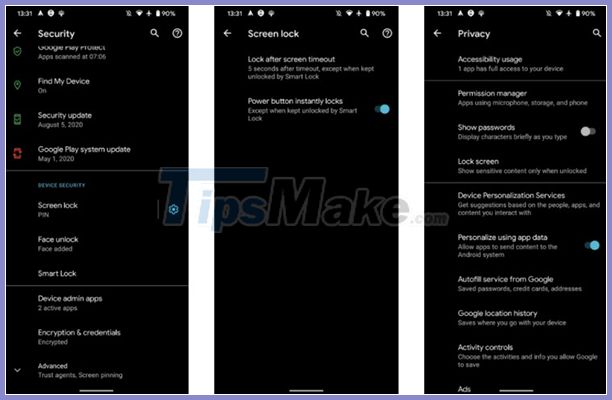
Click the icon next to Screen lock to change the choice. Features Lock after screen timeout will manage time after lock screen image off. You should select Immediately or 5 seconds so your device cannot be accessed by others.
4. Manage application access
Applications always ask for permission to access personal information on the device, such as location and contacts. Take the time to read those notifications before deciding whether to give the app access or not, to avoid the sensitive data being leaked out.
In Settings> Privacy> Permission Manager to view permissions sorted by items and control applications have access to it. When selecting an app, select See all permissions to review everything.
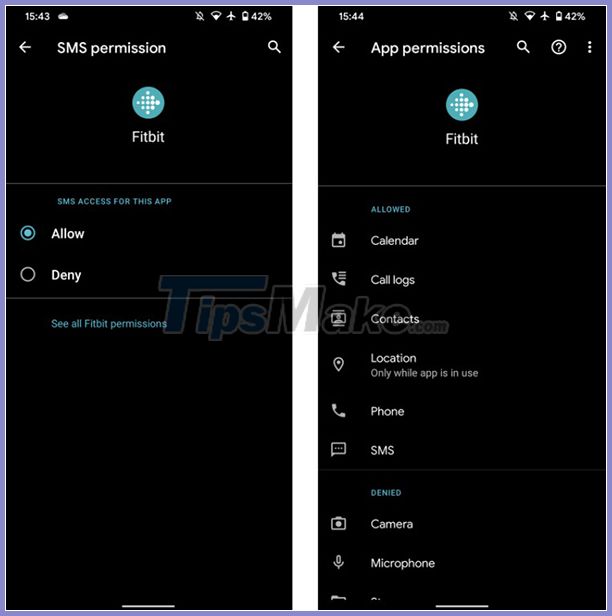
5. Activate Google privacy check
This is not quite an Android installation, but this one from Google can also help a lot in securing your phone.
In Settings> Google and select Manage your Google Account at the top. Scroll down to Security> Security issues found , select Secure account .
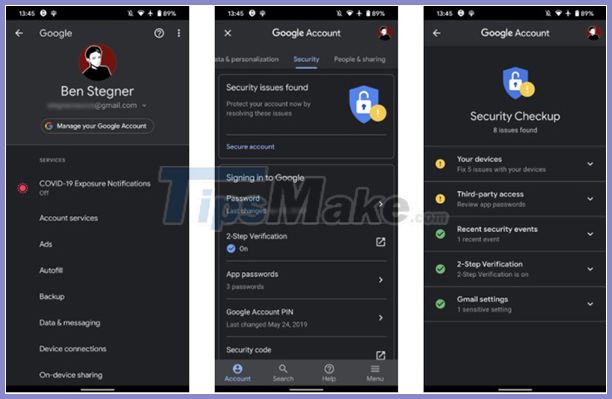
Google will suggest ways to better secure your account, such as removing your old device, enabling two-factor authentication (2FA), and revoking third-party app access. In particular, using 2FA is a must if you haven't already.
To access the tool from the web, visit the Google Security Checkup page.
6. Use the Safe Browsing feature in Chrome
Chrome is the default browser on most Android devices. Safe Browsing mode blocks most dangerous websites for your device. This feature will be enabled automatically, but you should also check to see if it works on your device.
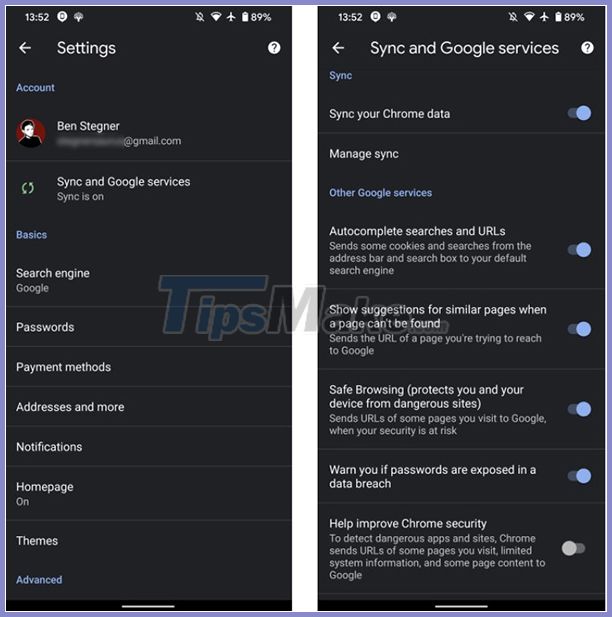
Open Chrome, click the Menu button with the 3-dot icon in the right corner, select Settings . Click on Sync and Google services and make sure the Safe Browsing option is selected.
7. Unauthorized installation of unknown source or search and detect errors via USB
If you are an advanced Android user, you may have toggled two useful settings toggled out, but it could also pose a greater security risk.
The first is to install apps from unknown sources. Also known as sideloading, they allow you to install APK files from anywhere you like, not just from the Play Store. While handy, enabling this feature also opens the door for apps to abuse privileges. Hence, you should turn off permissions unless you are currently installing a new app in this way.
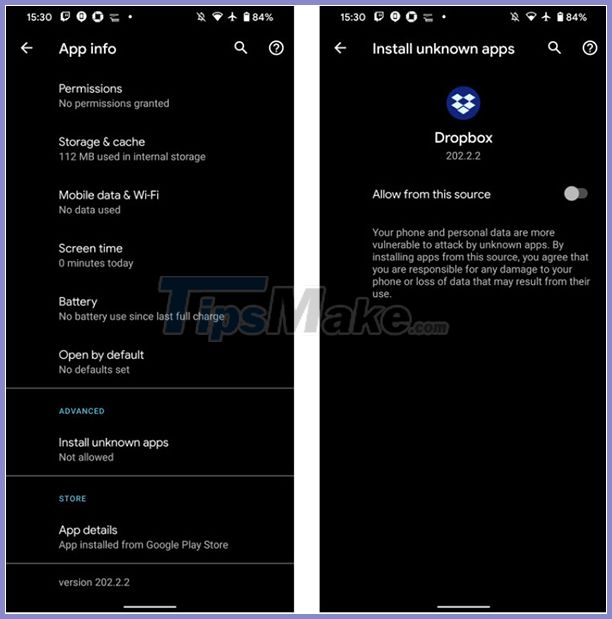
Another way is USB debugging, which allows your phone to communicate with the Android SDK on your computer. You can use this method to push apps to your phone and even perform advanced commands like root.
Just like sideloading, however, you should disable USB debugging when you're not using it. If not, someone can run a command on their phone if they use it.
8. Information in an emergency
Android lets you add contacts in the event of an emergency, and you should definitely install them.
To set up, go to Settings> About phone> Emergency information to add emergency contacts, medical information, and more. You can put this information outside the lock screen, when in danger will help helpers more easily identified.
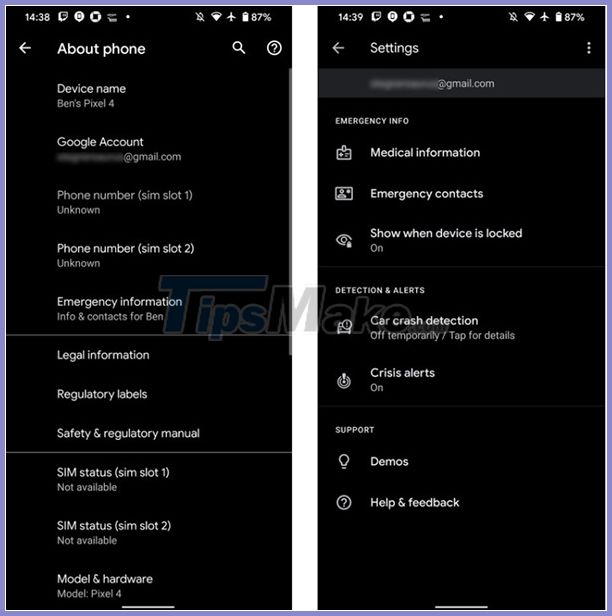
9. Lockdown mode
Android 9 introduced a new feature called Lockdown. This feature allows you to quickly hide all lock screen notifications and disable fingerprint unlock, face or other smart unlock options.
In Settings> Display> Lock screen display , turn on the Show lockdown option . To activate this mode, hold down the power button for a few seconds and click on Lockdown. You will have to enter your PIN or password to unlock your device later.
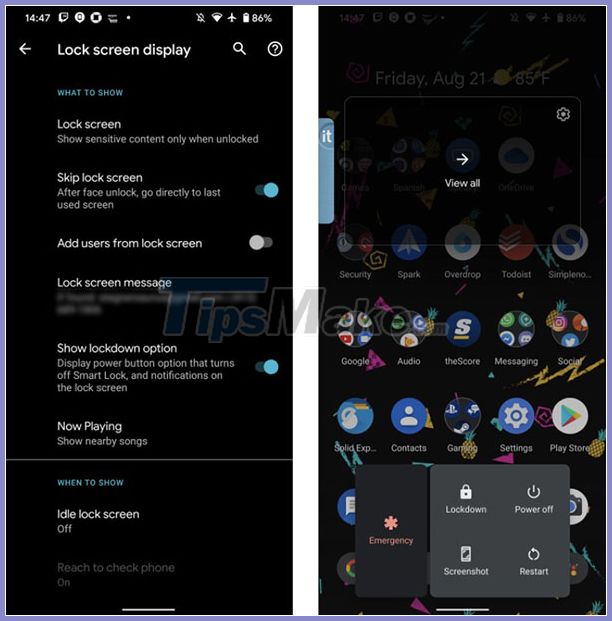
You should read it
- 6 useful Android settings you may not know yet
- Things to know about Android security patches
- Android 10 has 193 security errors that need to be processed before it launches on September 1
- How is Android One and Android Go different?
- 11 little-known Android tips to make your life easier
- New security feature on Android allows offline DNS requests
- Trojan root Android device bypasses Google's security mode on Play Store
- How to search for settings options in the Settings menu on Android
May be interested
- How to add more customizations to Quick Settings on Android
 from android 7.0 nougat version to android 8.0 oreo, users can intervene in the quick settings area to add more options for the device.
from android 7.0 nougat version to android 8.0 oreo, users can intervene in the quick settings area to add more options for the device. - How to search for settings options in the Settings menu on Android
 like other operating systems, android possesses 'countless' different settings options. these settings help optimize the user experience, but they also make the settings menu look like a 'mess' at times.
like other operating systems, android possesses 'countless' different settings options. these settings help optimize the user experience, but they also make the settings menu look like a 'mess' at times. - Samsung released an update to improve photography for the Galaxy S20
 samsung has just released a software update for the galaxy s20 series to further improve its camera performance, just weeks after the company released the may security patch for the device.
samsung has just released a software update for the galaxy s20 series to further improve its camera performance, just weeks after the company released the may security patch for the device. - How to Reset Android phone
 today's wikihow will show you how to reset (reset) your android device to its original settings using basic reset steps or recovery mode (restore factory settings) if your device encounter more serious problems.
today's wikihow will show you how to reset (reset) your android device to its original settings using basic reset steps or recovery mode (restore factory settings) if your device encounter more serious problems. - 4 Windows Security Settings Hackers Hope You Don't Find
 over the years, windows has really upgraded the system with some powerful protection features that most people overlook.
over the years, windows has really upgraded the system with some powerful protection features that most people overlook. - How to Use Find My Device for Android Devices
 this article shows you how to use the find my device feature developed by google to find your lost android device. although the find my device feature is enabled by default on most new android models, you will still need to adjust a few settings in advance to be able to track your lost phone or tablet.
this article shows you how to use the find my device feature developed by google to find your lost android device. although the find my device feature is enabled by default on most new android models, you will still need to adjust a few settings in advance to be able to track your lost phone or tablet. - Detect new malicious code to attack Android device
 symantec has discovered a new security threat, dubbed android.fakeneflic, that can exploit security holes on the android device's popular netflix application.
symantec has discovered a new security threat, dubbed android.fakeneflic, that can exploit security holes on the android device's popular netflix application. - Refresh your Android device in 5 ways
 before deciding to start a new android device, try the 5 new ways we share below. who knows, your device will probably work smoother. at that time, you could save a good amount of money for a new machine to use for something more important. please try to apply it.
before deciding to start a new android device, try the 5 new ways we share below. who knows, your device will probably work smoother. at that time, you could save a good amount of money for a new machine to use for something more important. please try to apply it. - How to Check RAM on Android
 today's tipsmake will show you how to check the amount of ram in use and total memory on your android device. while you can no longer check your ram in the 'memory' section of the settings app, you can use the hidden developer options menu to view ram statistics on your device. android devices. besides, you can also download the 'simple system monitor' application to view ram usage on any android device (only for samsung galaxy users will be the device maintenance application).
today's tipsmake will show you how to check the amount of ram in use and total memory on your android device. while you can no longer check your ram in the 'memory' section of the settings app, you can use the hidden developer options menu to view ram statistics on your device. android devices. besides, you can also download the 'simple system monitor' application to view ram usage on any android device (only for samsung galaxy users will be the device maintenance application). - There is no need to install any application, this is how to fix lag game on Android
 to improve the gaming experience on android you just need to tweak some settings on the device without installing any additional software.
to improve the gaming experience on android you just need to tweak some settings on the device without installing any additional software.










 Norton App Lock protects important and private apps on your smartphone
Norton App Lock protects important and private apps on your smartphone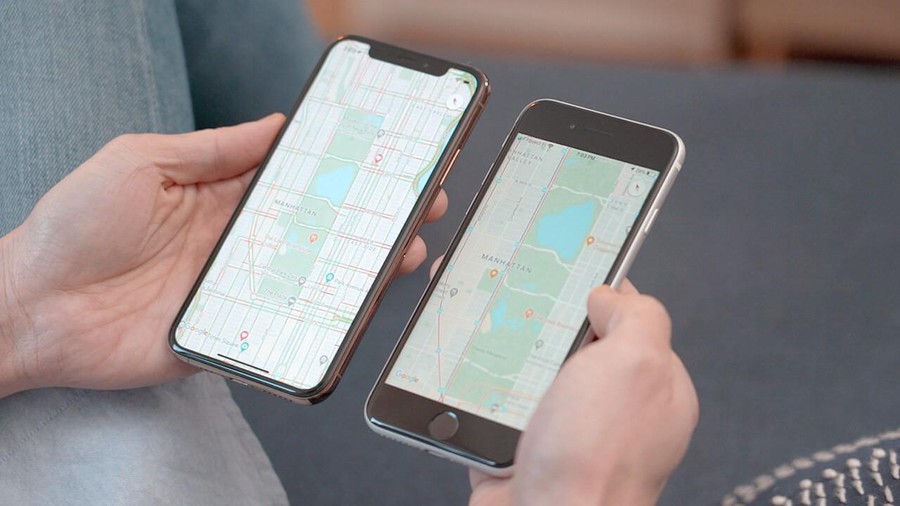 6 simple tips but make your phone more secure
6 simple tips but make your phone more secure Mass Logger: Keylogger is extremely dangerous with the ability to change the world of malicious code
Mass Logger: Keylogger is extremely dangerous with the ability to change the world of malicious code Win32: What is BogEnt and how to remove it?
Win32: What is BogEnt and how to remove it? What is Fleeceware? Instructions to prevent fleeceware stealing money from smartphones
What is Fleeceware? Instructions to prevent fleeceware stealing money from smartphones Detect a rare vulnerability that causes problems with the printer on Windows 10
Detect a rare vulnerability that causes problems with the printer on Windows 10